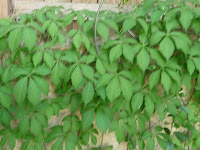
These trees seem about 30 m tall, (I'm bad a judgung distances, but at least 3 stories) with scaly leaves and small blue berries. The previous home owner had the ivy growing on the tress scraped, so they're now draped with dead vines. Not exactly the most pictureque thing to have gracing the center of the house, but I haven't figured out how to remove it.
These trees were called cedars because the wood is aromatic and historically cedars have been prized for their aromatic wood. So now these are the trees that cedar chests are made out of, but no one calls them "juniper chests". These trees also seems to be used to make pencils and flavor gin (etymology blog etnry on gin and junipers).

































